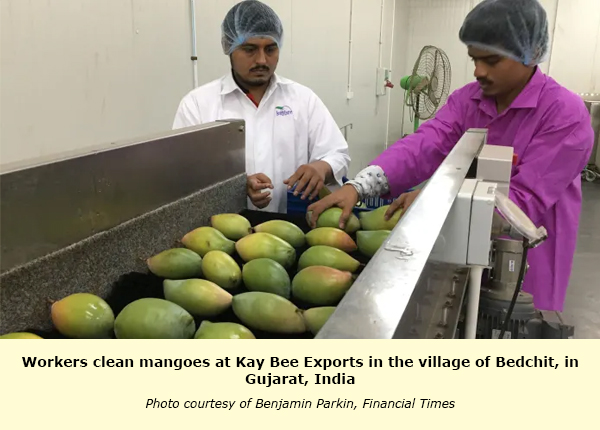The workers at Kay Bee Exports rolled the last of the season’s mangoes down a conveyor belt, brushing and washing the fruits until their marbled green skins glistened. From there, they were packed into crates by the dozen and trucked to nearby markets and airports, bound for shelves in London or New York in a matter of days.

Indian farmers grow about half the world’s mangoes, but in the village of Bedchit, in Gujarat state, the season is ending on a sour note for exporters after a recent bust-up over trade with the US threatens plans to boost global sales. There were hopes the two countries would be able to break an impasse in their stalled bilateral trade deal during a visit by US officials to India last week, but neither side has announced any concrete progress.
Mango farmers, alongside diverse industries across India, have been banking on the two countries to finish a much-awaited trade package to improve access for hundreds of millions of dollars in goods, ranging from US dairy and medical devices to Indian steel and fruit, including mangoes.
But talks have been derailed by a round of tit-for-tat tariff sparring between Washington and New Delhi. Indian farmers were particularly dismayed by a US move in March to cancel duty-free benefits on Indian imports worth about USD 6bn.
Indian farmers and trade officials are unequivocal that their mangoes are the world’s tastiest. Varieties such as the Alphonso, known for its sweet and creamy interior, have gained an international following among celebrity chefs such as Gordon Ramsay. Former US president George W Bush, when presented with an Indian mango on a visit in 2006, reportedly described it as “a hell of a fruit”.
The lack of success increasing exports, chiefly to the all-important US market, is therefore a continued source of chagrin. India exports about USD 3m a year’s worth of mangoes to the US, the largest importer, compared with more than USD 100m that Americans buy from Mexico. Total mango exports fell 5 per cent in the year ending in March from a year earlier.
“Exports have not increased,” said Insram Ali, president of the mango growers’ association. “We tried very hard, wrote to the central and state government. The process is very difficult and expensive. It is now too late for this year’s mango season.”
Boosting India’s agricultural exports to counter rural economic malaise is a key goal of Prime Minister Narendra Modi’s government. “Horticultural products are big business in India,” said Biswajit Dhar, a trade economist at Jawaharlal Nehru University in Delhi. “For India, [exporting more to the US] would add to farmers’ income in a very significant manner.”
To sell to the US, Indian mango producers need to fund American agricultural officials to fly to India and inspect the process, a burden India said added thousands of dollars in expenses and should be left to local officers.
The exporters then transport their produce by air, because the delicate fruit will not survive the sea voyage. All that means a shipment can cost about USD 25,000 and retail in the US for as much as USD 25 a box, several times the price of Latin American alternatives.
The US is one of India’s largest trading partners, with India exporting USD 83bn in goods and services in 2018. Some analysts say that is below potential, hampered by a disorganised export sector in India and bureaucratic procedures on both sides that could be smoothed out by a trade deal.
But latent tension between the two countries has boiled over under President Donald Trump’s more muscular trade policies. Mr Trump last week continued a recent verbal assault, saying in a tweet that “India has long had a field day putting Tariffs on American products. No longer acceptable!”
Kaushal Khakhar, chief executive of Kay Bee, one of the largest Indian mango exporters, said the US market was ripe with possibility — if only costs could come down. “The main challenge is to make it viable. Even if the flavour is superior, we’re not able to break into the market,” he said.
Mr Khakhar, whose company exports a range of fruit and vegetables around the world, was aware of the risks of getting tangled in trade tensions. The US last year banned the import of pomegranate seeds from India after discovering a fruit fly in a shipment, a response producers called excessively heavy handed. Mr Khakhar said he lost almost 10 per cent of his sales as a result.
Chintan Patel, a farmer in Bedchit who supplies mangoes to Kay Bee’s nearby facility, said the fruit presented a more lucrative option than sugar cane. He wanted to buy more land for his mango orchard, but income had not risen enough to make that a reality. “It’s not an easy thing, but we aspire to do it,” he said.
For now, Indian mango farmers must content themselves with one loyal group of American customers who will keep buying, trade dispute or not: the US’s 4m-strong Indian diaspora.
“They’re well aware of the superiority of these mangoes,” said Mr Khakhar. “They don’t need any convincing.”
Source: Benjamin Parkin, Financial Times
